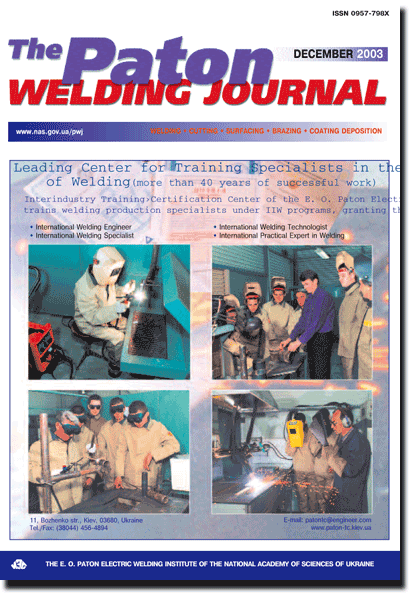

| SCIENTIFIC AND TECHNICAL | |
| Petushkov V.G.
Residual stresses in explosion treated pipes. | 2 |
| The problem of inducing circumferential compressive residual stresses in pipes has been studied. Topicality of such studies is attributable to the possibility of using their results to form the assigned fields of residual stresses and strains in pipelines in order to prevent extended fractures and relieve residual welding stresses by explosion treatment, as well as to develop a sufficiently simple procedure for estimation of its efficiency. Described is the approximation procedure for analytical estimation of stresses induced in a thin-walled pipe with a single annular explosive charge, provided that distribution of plastic strains along the generating line is close to the axially symmetric one (assumption of an instantaneous detonation of the explosive charge). Suggested also is a principle of modelling the stress fields thus induced in pipes of different dimension types. | |
| Ryabov V.R., Muravejnik A.N., Kharchenko G.K. and Falchenko Yu.V.
Specifics of formation of structure of joints, made from dispersion-strengthened composite Al + 4 % C, in diffusion bonding. | 6 |
| It is shown that the quality joints of CM 1013 and 1501 with 4 % C can be obtained in using an aluminium ductile interlayer. Optimum conditions of diffusion bonding in vacuum are given. Strength of joints of CM 1501 + 4 % C reaches 443.8 MPa, while that of CM 1013 + 4 % C joints is 295 MPa. | |
| Gretsky Yu.Ya. and Maksimov Yu.S.
Effect of hydrostatic pressure on arc stability in underwater welding (Review). | 10 |
| The problem of ensuring stability of the arc burning in water under conditions of high ambient hydrostatic pressure is considered. Current notions of causes of instability of the arc discharge are presented. Input principles are formulated for arrangement of studies to be conducted under the above conditions to solve the problem of expansion of technological capabilities of the method of mechanised underwater flux-cored wire welding developed by the E.O. | |
| Saidov R.M., Semmler U., Matthes K.-J. and Thurner S.
Application of flux in MIG welding of thin-sheet aluminium alloys. | 13 |
| Results of investigation of arc consumable electrode inert gas welding of thin-sheet aluminium alloys using a cleaning and forming flux are presented. It is shown that the use of flux in welding aluminium alloy AlMg4.5Mn (5083) promotes producing of welded joints of a high quality and level of mechanical properties. | |
| Dzyuba V.L. and Kalyuzhny G.S.
Effect of power circuit parameters on fluctuations of current in turbulence-type plasmatrons (calculation experiment). | 18 |
| Dependence of values of large-scale current fluctuations in turbulence-type plasmatrons upon the power circuit parameters has been studies by the method of a calculation experiment. As shown by its results, the value of the arc current fluctuations first decreases with increase in the natural frequency of the power circuit, and then remains approximately at a constant level that lowers with increase in circuit inductance. | |
| INDUSTRIAL | |
| Paton B.E. and Leskov G.I.
Some aspects of electron beam welding application. | 22 |
| The paper presents the energy properties of the electron beams as heat sources in welding. Possibility of welding structures of steel with up to 150 mm wall thickness, of alloys of aluminium (up to 250 mm) and titanium (up to 200 mm) is demonstrated. Features of thermal cycles of the metal of welds and HAZ and welded joint deformations are pointed out. Equipment is recommended for shop sections, where EBW of various items is performed. The main technological operations are described, which provide the high quality of welds. | |
| Kuchuk-Yatsenko S.I., Krivenko V.G., Bondaruk A.V. and Didkovsky A.V.
Flash-butt welding of rails. Experience of application and prospects for improvement. | 27 |
| The paper describes an efficient process of flash-butt welding of rails, namely pulsed flash-butt welding, which was developed at the E.O. Paton Electric Welding Institute. This process allowed reducing the flashing allowance and welding time, while improving its stability and quality. | |
| Nazarchuk A.T., Snisar V.V. and Demchenko E.L.
Portioned heat input as a method to control structure of the weld and HAZ metal. | 34 |
| Peculiarities of manual arc welding with a portioned weld formation are considered. Advantages of this method compared with continuous arc welding include widening of the capabilities of controlling the weld and HAZ metal structure and improvement of mechanical properties and technological strength of welded joints. | |
| BRIEF INFORMATION | |
| Tsybulkin G.A.
Effect of sliding contact in current conductor of torch on stability of arc welding process. | 37 |
| Sufficient conditions were obtained which guarantee the asymptotic stability of the consumable electrode arc welding process in case when the electric field intensity in arc column and resistance of a sliding contact in a current-carrying tip vary within some known boundaries. | |
| Pritula S.I., Tkachenko V.A., Lebedev V.A. and Buryak Ya.Z.
Device for programmable commutation of welding circuit in arc welding equipment. | 39 |
| Capabilities of systems of commutation and adjustment, based on controllable transistor-type commutators, are systematized and described. The rationality of use of these devices is shown for the solution of a complex of technical and technological problems. Conception of modular designing of devices of a programmable commutation of the welding circuit using a controllable transistor-type commutator has been suggested. | |
| Block of synergic control of pulsed submerged-arc welding. | 42 |
| Index of articles for TPWJ'2003, No.1-12. | 43 |
| List of authors. | 49 |
(You are viewing the simplified file contents)
Sorry, the PDF of this issue is not yet available
The cost of subscription/purchase order journals or individual articles
| Journal/Currency | Annual Set | 1 issue printed |
1 issue |
one article |
| TPWJ/USD | 384 $ | 32 $ | 26 $ | 13 $ |
| TPWJ/EUR | 348 € | 29 € | 24 € | 12 € |
| TPWJ/UAH | 7200 UAH | 600 UAH | 600 UAH | 280 UAH |
| AS/UAH | 1800 UAH | 300 UAH | 300 UAH | 150 UAH |
| AS/USD | 192 $ | 32 $ | 26 $ | 13 $ |
| AS/EUR | 180 € | 30 € | 25 € | 12 € |
| SEM/UAH | 1200 UAH | 300 UAH | 300 UAH | 150 UAH |
| SEM/USD | 128 $ | 32 $ | 26 $ | 13 $ |
| SEM/EUR | 120 € | 30 € | 25 € | 12 € |
| TDNK/UAH | 1200 UAH | 300 UAH | 300 UAH | 150 UAH |
| TDNK/USD | 128 $ | 32 $ | 26 $ | 13 $ |
| TDNK/EUR | 120 € | 30 € | 25 € | 15 € |
AS = «Automatic Welding» - 6 issues per year;
TPWJ = «PATON WELDING JOURNAL» - 12 issues per year;
SEM = «Electrometallurgy Today» - 4 issues per year;
TDNK = «Technical Diagnostics and Non-Destructive Testing» - 4 issues per year.


